Is a high pressure of 140 considered high blood pressure?
A systolic blood pressure ≥ 140 mmHg and/or a diastolic blood pressure ≥ 90 mmHg is considered high blood pressure, and your case has reached the upper limit of hypertension.
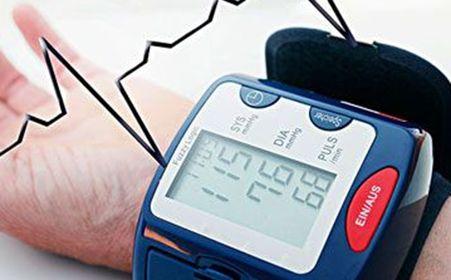
The daily dietary regimen for hypertension is as follows:
1, low fat, low cholesterol: fat intake should be controlled at less than 25% of the total caloric energy, and mainly vegetable fats and oils, cholesterol intake is less than 300 mg per day. Eat low-fat and high-fiber vegetables, especially lipid-lowering foods, such as onions, garlic, shiitake mushrooms, fungus, seaweed, kelp, etc. Eat more sea fish rich in unsaturated fatty acids and vegetable oils, such as corn oil and sunflower oil. Try not to eat stimulating foods. In addition, high-fat food should not be consumed at dinner and before bedtime to avoid elevated blood lipids.
2, eat more blood pressure-lowering foods, especially medicinal foods such as buckwheat, mulberry leaves, wolfberry, chrysanthemum, cassia seeds, acacia rice, etc., you can match these six foods together with a decoction of water to serve, one dose a day, can effectively lower blood pressure, blood lipids, prevention of hypertension and cardiovascular disease, you can also buy buckwheat and mulberry leaves directly on the Internet to drink the fermented products, the same formula, fermented, which the content of the medicinal ingredients and the medicinal effect is relatively high, generally 6-12 times higher than traditional food.
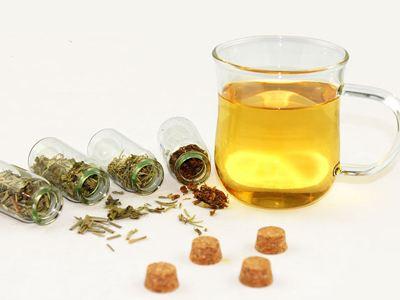
3, eat more high potassium, magnesium, calcium: potassium salts, calcium, magnesium can reduce the role of high sodium dietary damage to blood vessels, low calcium, low magnesium and calcium, magnesium metabolism abnormalities can be able to trigger high blood pressure, China's high sodium and low-potassium diet is one of the factors of the high incidence of high blood pressure. All kinds of green vegetables, roots and tubers and milk are rich in potassium, calcium and magnesium. Bananas, apricots, plums and poultry, fish and lean meat are rich in potassium.
The following measures are taken to regulate the daily life of hypertension:
1. Salt restriction. Limit salt intake to less than 5 grams per day.
2. Weight loss. Fat people should avoid "heavy" on "light", should not be more to protect "heavy", all patients can not be more "refueling". Reduce the intake of animal fat, limit the total daily food calories, change bad eating habits, eat more vegetables rich in plant fiber.
3. Exercise. Aerobic exercise can reduce blood pressure as well as weight loss, such as walking, jogging, playing tai chi, cycling and swimming can be chosen.
4. Stop smoking and drinking .
5. Blood pressure should be measured frequently, 2-3 times a week.
It is not possible to make a simple definition with a single measurement result value. The premise of our diagnostic criteria for hypertension is that adults over 18 years of age, without taking antihypertensive drugs, generally need to be judged by non-same day measurements 3 times according to the results (previous history of hypertension, after taking antihypertensive drugs blood pressure control within the normal range is also considered hypertensive patients). The definition and classification of blood pressure in China are detailed in the table below:
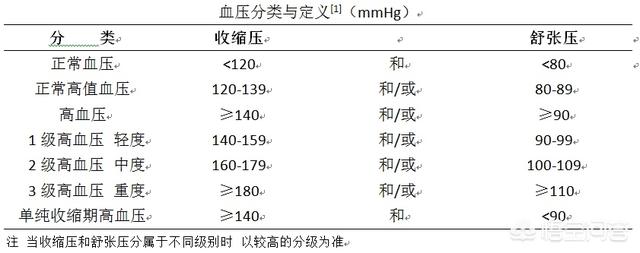
In addition to performing daily self-monitoring of blood pressure in normal life, dietary habits can be adjusted to reduce high-risk factors that raise blood pressure. This includes the following [1]:
Reduce sodium intake. Under normal circumstances, the body's need for sodium is 0.5-1g/d. In daily life, most people's dietary salt content is 10-15g/d, far exceeding the body's needs, so it is recommended that the daily intake per person should be less than 5g.
Increase foods containing potassium, magnesium and calcium. Potassium, magnesium and calcium have antihypertensive effects.
Limit energy intake and control body weight. Adjust eating according to age and labor intensity.
Reasonable adjustment of the ratio of fat, fatty acid and protein. The ratio of saturated fatty acid to unsaturated fatty acid intake should be 1:1.5, vegetable oils should be the mainstay, and more fish protein should be consumed.
Avoid alcoholism, it is advisable to quit smoking. Alcohol consumption should be limited to less than 25g (50 g of white wine), studies have shown that reducing alcohol consumption by 4-6w, blood pressure can be reduced, but 1 two red wine per day can achieve the effect of lipid regulation, and alcohol should be completely abstained from if necessary. Should not smoke, drink less coffee, can drink green tea.
Supplement crude fiber, dietary fiber. Dietary fiber can not only achieve the purpose of controlling calorie metabolism, but also increase the feeling of satiety, but also promote gastrointestinal peristalsis, prevent constipation, reduce the absorption of sugar and fat, and reduce the damage of high blood lipids on the blood vessel wall.
Supplementation of vitamin C and water. Serum vitamin C content and blood pressure is negatively correlated, daily to drink a moderate amount of warm water (preferably early in the morning to drink a glass of water), has the role of regulating blood viscosity can purify the blood and can pass stools.
[Reference]
[1] Liu Lisheng. Guidelines for the prevention and treatment of hypertension in China 2010[J]. Chinese Journal of Hypertension,2011,19(08):701-743.
Author: Wang Yu, Department of Pharmacy, No. 477 Hospital of PLA, and member of Pharmacy Network
The authoritative interpretation of Pharmaceutical Affairs, unauthorized reproduction, plagiarism will be punished.
If you have a high pressure of 140, are you categorized as a hypertensive patient? This question cannot be generalized, and today we will discuss the issue of confirming a diagnosis of hypertension.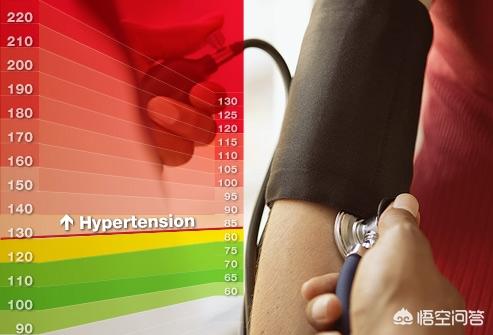
Diagnostic criteria for hypertension
Now living conditions are getting better and better, measuring blood pressure in addition to going to the hospital, many families are also equipped with arm band or wrist blood pressure monitor, for different situations of blood pressure measurement value, want to confirm whether it is high blood pressure, different measurement methods, the standard of its judgment is also different.
First of all, the office measurement, for the office measurement of blood pressure, the general requirements for the first measurement of bilateral upper arm blood pressure, take the higher side (usually the right side), both sides of the blood pressure measurement value should not be more than 20mmhg, if there is a large difference between the situation, should be looked for to confirm the cause. If the high pressure measured in the office is more than 140mmhg, and the low pressure and or higher than 90mmhg, after ruling out the factor of high blood pressure due to the stress factor of medical treatment, it should be rechecked twice in four weeks, and if the value of the three measurements of the blood pressure on non-same day is higher than 140/90mmhg, the diagnosis of high blood pressure can be confirmed.
For home measurement of blood pressure, taking into account the sphygmomanometer and the measurement of incorrect posture and other factors, the general will be measured many times blood pressure more than 135/85mmhg, can be considered to be the existence of hypertension, of course, want to diagnose, it is best to go to the hospital for clinic measurements to confirm the diagnosis of the best.
There is another way of measuring blood pressure, dynamic blood pressure monitoring, which refers to a way of measuring blood pressure in which the patient carries the relevant equipment to monitor in real time the pattern of blood pressure fluctuation of the patient within 24 hours, in order to diagnose the presence of hypertension in the patient, which is also meaningful for figuring out the pattern of blood pressure of the patient with hypertension, and confirming the diagnosis of high blood pressure. In this case, if the blood pressure exceeds 135/85 mmhg during the day, 120/79 mmhg at night, and the 24-hour average blood pressure exceeds 130/80 mmhg, the diagnosis of hypertension is confirmed.
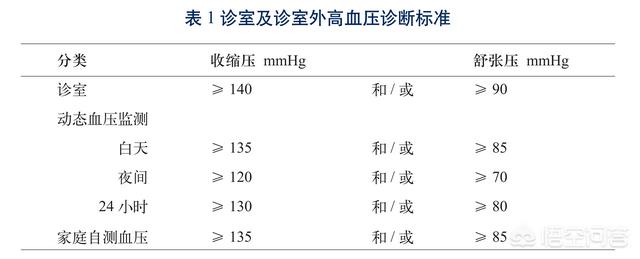
What to make of the high-pressure 140 situation
If you confirm multiple measurements of blood pressure systolic blood pressure value are in the 140mmhg or so, in time does not meet the criteria for the determination of high blood pressure, for example, your clinic measured value is 138mmhg, this time should also be taken seriously, after all, this is a borderline high blood pressure, high blood pressure this kind of disease, is often gradual, your recent measurement of high pressure of 140, in the first half of the year after going to the measurement, it may be The first time you measure high blood pressure is 140, and if you measure it again in the next six months, you may be able to diagnose hypertension.
Therefore, for the clinic blood pressure measurement has been in the 140mmhg or so, has not yet been diagnosed with hypertension friends, should be taken as early as possible life intervention, low-salt diet, obesity control, moderate exercise, smoking cessation and limitation of alcohol, calm state of mind, quit anxiety, maintain good work and rest and sleep, to do the above points, your blood pressure after six months of measurements may come down, if you don't care about it, continue to adhere to the bad habits, then after six months of measurement, you may be able to be diagnosed as high blood pressure. If you do not care and continue to adhere to poor lifestyle habits, then you may be diagnosed with hypertension when your blood pressure is measured six months later.
A high pressure of 140 is considered high blood pressure.
Hypertension is a clinical syndrome characterized by increased arterial blood pressure (systolic and/or diastolic) in the body circulation (systolic ≥140 mm Hg, diastolic ≥90 mm Hg), which may be accompanied by functional or organic damage to organs such as the heart, brain, and kidneys.
According to the criteria of the Chinese Guidelines for the Prevention and Control of Hypertension, the same criteria for grading hypertension in the general adult population are as follows:
1. When the systolic blood pressure is less than 120 mmHg and the diastolic blood pressure is less than 80 mmHg, the blood pressure is within the normal range.
2. When the systolic blood pressure is between 120-139 mmHg and/or the diastolic blood pressure is between 80-90 mmHg, the blood pressure is normally high.
3. When the systolic blood pressure is greater than 140-159 mm Hg and/or the diastolic blood pressure is between 90-99 mm Hg, it is classified as first-degree hypertension (mild).
4. When the systolic blood pressure is greater than 160-179 mm Hg and/or the diastolic blood pressure is between 100-109 mm Hg, it is classified as second-degree hypertension (moderate).
5. When the systolic blood pressure is greater than 180 mm Hg, and/or the diastolic blood pressure is between 110 mm Hg, it is classified as grade 3 hypertension (severe).
Hypertension is both an independent chronic disease and an important risk factor for cardiovascular disease. If you find yourself suffering from high blood pressure, you need to consult a doctor and take medication in a timely manner and pay attention to your daily diet, work and rest to prevent your blood pressure from rising further.
Dr. Guo Xiaohui, Dr. Ma's Health Group
A few days ago my brother-in-law called me, said his physical examination results came out, his blood pressure is 140/86mmHg, the doctor in charge of the examination gave 3 times to measure, the value is similar, the doctor said it should be high blood pressure, in order to rule out the white coat hypertension, it is recommended to measure at home a few times, if they are more than 140/90mmHg, you can be diagnosed with high blood pressure. Brother-in-law has been at home for the past few days to measure blood pressure, systolic blood pressure between 135-145mmHg, diastolic blood pressure between 85-92mmHg, he is a little confused, the doctor said more than 140/90mmHg even if high blood pressure, then this a moment over a moment not how to count?
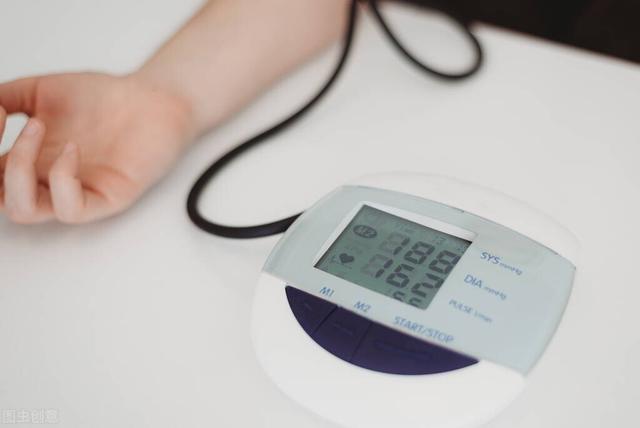
I smiled and explained to him, the current guidelines recommend systolic blood pressure of more than 140mmHg or diastolic blood pressure of more than 90mmHg need to be treated with medication to lower blood pressure, you are now in this situation is already considered high blood pressure, but for the time being, you can not use medication, will be obsessed with alcohol and smoking quit; and then participate in a little less wine, less oily food; more exercise exercise, don't do nothing to lay down and look at the cell phone, will be the key to control their weight within The key is to keep your weight within the normal level; if you really can't control your mouth, take diet pills to assist you, the only diet pill approved by the state, orlistat capsule is good, you can try it; adhere to the measurement of blood pressure to see if it can be reduced.
A high pressure of 140 is already considered high blood pressure, but usually in this case, doctors do not recommend medication, are recommended to carry out lifestyle control, after 3 months if the blood pressure has improved, you can not take medication, but if the blood pressure does not improve, or even become higher, you need to take medication to control blood pressure.
High blood pressure is known as a chronic disease of old age, a symbol of the aging of the body's functional tissues, but young people suffer from high blood pressure for none other than the following reasons, which require more attention:
1. Genetic factors: If one or both members of a couple have high blood pressure, the chances of their children having high blood pressure are increased.
2. Smoking and drinkingTobacco contains nicotine, which stimulates the central nervous system and sympathetic nerves, accelerates the heart rate, and prompts adrenaline to release a large number of catecholamines, causing small arteries to constrict, which leads to increased blood pressure; long-term heavy smoking will make the blood vessels sclerosis, arterial endothelium hypoxia, the oxygen content of the arterial lipids increased, accelerating the formation of atherosclerosis.
People who consume large amounts of alcohol will increase the excitability of the sympathetic nervous system, increasing the heart rate and the amount of blood being pumped out of the heart, and as a result, they will also experience symptoms of high blood pressure.

3. Excessive salt intake
Dietary guidelines recommend a daily salt intake of no more than 6g, but most people are over the limit, especially those who like to go down to the restaurant, the restaurant in order to pursue the flavor, will make the dishes very salty and fresh, a meal intake of salt in the body will be far from the amount of the day. Therefore want to prevent high blood pressure, the most important thing is to control the amount of salt intake.
4. Overweight
If we are careful, we will find that hypertensive patients, especially young hypertensive patients are predominantly fat. The reason for this is that clinical studies have shown that the incidence of hypertension in obese people aged 20-30 years is one times higher than that in non-obese people, while the incidence of hypertension in obese people aged 40-50 years is also 50% higher than that in non-hypertensive patients.
Therefore, if the blood pressure reaches 140, the most important thing is to actively carry out lifestyle intervention, and if the effect of intervention is not obvious, we should consider taking medication to control the blood pressure within the normal range in order to minimize complications.
I am Pharmacist Wang, insisting on spreading knowledge of diseases in simple and easy-to-understand words, and dedicating my own small contribution to a healthy China. If you think my answer is helpful to you, please leave a like! In addition, if you still have related questions, welcome to leave a message, we discuss together!
Too little information was provided, but as a cardiovascular physician, I'll answer in detail in several ways as follows:
Repeatedly according to our medical guidelinesproperlyAfter measurement.
1.Clinic systolic blood pressure ≥ 140 mmHg and/or clinic diastolic blood pressure ≥ 90 mmHg. can beconsidered hypertension (see Table 1).

Table 1 shows the classification of hypertension based on office blood pressure
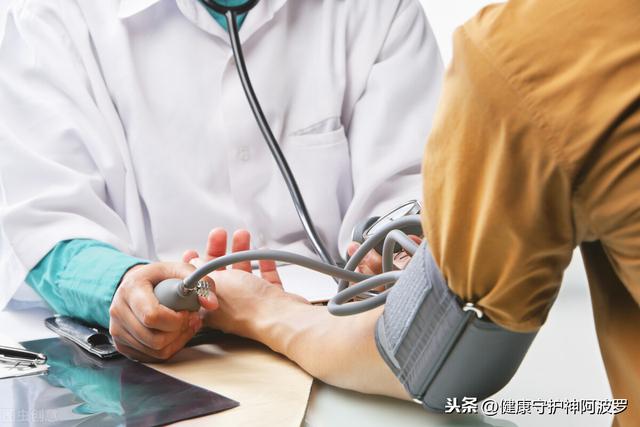
2. The diagnostic criteria for hypertension in home self-measurement of blood pressure and ambulatory blood pressure monitoring are not simply the above mentioned≥140 mmHg and/or diastolic blood pressure ≥90 mmHg.See Table 2 for details; these definitions of blood pressure apply to all adults (>18 years).

Table 2: Criteria provided for defining ambulatory and home blood pressure for hypertension
Therefore, you compare it to your own scenario to see if it is considered high blood pressure.
1. If the blood pressure is self-measured at home and is the average of several measurements, then it is definitely high blood pressure, the
2. If it is only the result of an occasional measurement, then congratulations, it is entirely possible that it is not high blood pressure, even though your condition has reached the upper limit of high blood pressure. This is because medical guidelines state that the average of blood pressure must exceed the above criteria in 3 measurements taken on non-simultaneous days for a diagnosis of hypertension to be made.
Of course all blood pressure values are based on the correct measurement of blood pressure, how to measure blood pressure correctly?
1. To measure blood pressure at home, it is recommended to choose the upper arm type electronic sphygmomanometer, electronic sphygmomanometer is more convenient and safe to operate, you can use it yourself, and the measurement data of the upper arm type is more stable and accurate than that of the wrist type and finger type sphygmomanometer.
2. In the 30 minutes before measuring blood pressure, you should not smoke, drink alcohol, tea, strenuous exercise, etc., and you should not take antihypertensive drugs.
3. To maintain emotional stability, the environment is quiet, do not talk or do other actions in the measurement process, in the measurement of the dress should be relatively loose, especially the sleeve can not be too tight, the sleeve is too tight, hard to roll up the sleeve will lead to inaccurate measurement data.
4. The ideal time for measurement is in the morning when you just get up, if you are a hypertensive patient, it is best to take antihypertensive drugs and eat breakfast before, the measured data is minimally affected, can be measured in the morning and evening, and recorded.
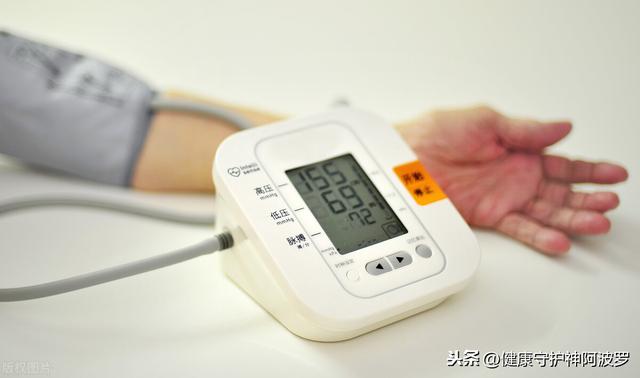
If you have been diagnosed with high blood pressure, you must pay attention to it in your regular life:
1. Reduce sodium intake and do not consume too much salt, including invisible salts
2. Control the intake of high-sugar and high-fat foods.
3. Adhere to exercise to avoid high blood pressure caused by overweight and obesity.
4. Stop smoking and limit alcohol, as tobacco and alcohol are also risk factors for high blood pressure.
If after the above diet and lifestyle, blood pressure is still not controlled, then regular cardiovascular medicine must be administered and blood pressure brought up to standard.
Otherwise, long-term high blood pressure triggers diseases such as coronary heart disease and cerebral infarction.
Hello! To answer your question, in a few ways:First, find out your . Gender, age? Because, in addition to individual differences in blood pressure there are gender and age differences. A high pressure of 140 and a low pressure of 90 is known medically as systolic blood pressure, high pressure. Diastolic, low, ...]For people over 60 years old, it is normal. But for young people. It is considered high blood pressure.In general. , women have lower arterial blood pressure before menopause than men of the same age, and higher arterial blood pressure after menopause, and arterial blood rises gradually with age in both men and women. The increase in systolic blood pressure is more pronounced than the increase in diastolic blood pressure. Secondly, how do you measure it? If, once in a while doesn't count. Normal blood pressure doesn't stay at one level all the time, it fluctuates. Also, the environment in which the blood pressure is measured and emotions, medications, and body position have an effect on blood pressure. Therefore, it is important to remove these factors from the measurement to get the true blood pressure data. The standard blood pressure for adults in China is.
1 Normal blood pressure, systolic <120mmHg,. Diastolic blood pressure <80mmHg
2Normal high values, systolic blood pressure 120--139 mmHg, diastolic blood pressure .80--89 mmHg
3 Hypertension with systolic blood pressure ≥ 140 mmHg and diastolic blood pressure ≥ 90 mmHg.
You cross-reference it! See if your blood pressure is high or low?
I'm a national level 2 public dietitian, Su Yanjing, member of Liaoning Dietitians Association, member of Liaoning Dietitians Office.
Blood pressure is one of the important indicators of human health status, people with high blood pressure in the family configuration of a blood pressure monitor is necessary to measure blood pressure can be timely understanding of the situation of blood pressure.
Normal human blood pressure values, with age and rise, the blood pressure of the elderly over 60 years of age systolic blood pressure more than 140 mm Hg, diastolic blood pressure more than 90 mm Hg is called high blood pressure. The ideal blood pressure is 120 mm Hg systolic and 80 mm Hg diastolic.
Hypertension is categorized into primary hypertension and secondary hypertension. Primary hypertension: refers to high blood pressure of unknown cause, accounting for more than 90%, may be related to the following factors: such as heredity, salt intake, smoking, overweight, alcoholism, lack of exercise, mental stress, and at present difficult to cure but can be controlled after taking medication.
Secondary hypertension:Elevated blood pressure has a definite cause and accounts for 5% to 10% of cases. This type of hypertension may be caused by kidney disease, endocrine disease and other causes.
What do people with high blood pressure need to be aware of in their normal lives?
1, adjust the lifestyle: to reasonable diet, moderate exercise, quit smoking and alcohol, psychological balance. In addition to medication, you should also change your daily bad habits to match the treatment. ①, reduce body weight and quit drinking. Reducing body weight can help patients lower their blood pressure; drinking alcohol can increase blood pressure level and increase the prevalence of hypertension, so hypertensive patients should quit drinking. Dietary control. Eat less fat-containing fat, eat more potassium, calcium-containing foods such as fresh milk, beans, dark green vegetables, low-fat diet, and increase protein foods. Reduce salt intake, no more than 6 grams per person per day. Limit salt first to reduce the cooking salt and salt-containing seasonings, eat less salty dishes and salt pickles. ③, aerobic exercise. Aerobic exercise can reduce blood pressure as well as weight loss, such as walking, cycling and swimming. Reduce mental stress and maintain psychological balance. We should find more positive factors in life, treat life with optimism, and pursue spiritual happiness. Hypertension is one of the psychosomatic diseases, such as anxiety, nervousness, anger, fear and other emotional factors are not only important factors in hypertension, nervousness will lead to the person's sympathetic nerve excitation, resulting in increased blood pressure. Nervous dysfunction itself is the cause of the development of hypertension. ⑤, Blood pressure is easy to rise in winter and relatively low in summer, hypertensive patients should pay attention to the sharp climate change and avoid the effect of disparate temperature difference on blood pressure. (6) Medication. The medication for hypertension should vary from person to person depending on the condition. Control blood pressure at <140/90 mmHg with medication. All medications have certain side effects, use medication under the guidance of a doctor and do not easily reduce or stop medication.
First of all, high blood pressure does not mean that you have high blood pressure when you take a blood pressure test. There are many factors that can affect your blood pressure, such as excitement when taking a blood pressure test, waking up in the morning, or not having a good night's rest the night before, all of which can affect your blood pressure.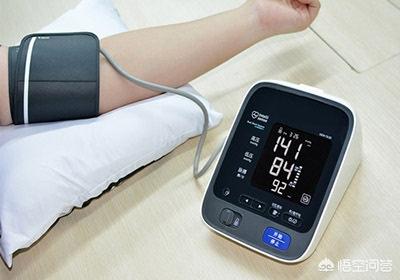
A diagnosis of hypertension can be made if three consecutive blood pressure checks are at 140 mmHg, that is, systolic blood pressure is higher than 140 and diastolic blood pressure is higher than 90!
There are also a number of clinical responses to symptoms that can be used as a reference for a definitive diagnosis of hypertension, for example:
Dizziness, headache, blurred vision, ringing in the ears, insomnia, fatigue, poor concentration and other symptoms after mental stress, emotional excitement or exertion may be due to higher mental dysfunction. In the early stage, blood pressure is only temporarily elevated, but it continues to rise as the disease progresses, with corresponding changes in the brain, heart, and kidneys.
There are also many different types of high blood pressure:
According to the urgency of onset and progression of the disease, it can be categorized into slow-onset and acute-onset, with the slow-onset being the most common.
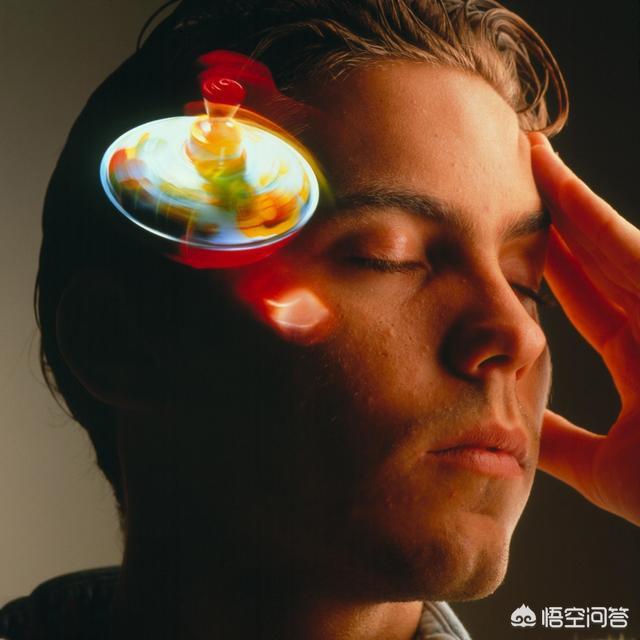
Acutely progressive hypertension, also known as malignant hypertension, accounts for about 1% of hypertensive disorders and can be a sudden transition from a slowly progressive form. It is most common in 30-40 years old. Diastolic blood pressure is mostly above 130mmHg, with symptoms such as weakness, thirst and polyuria. There is rapid loss of vision, retinal hemorrhage and exudation in the fundus, and often bilateral optic nerve papillary edema. Rapidly out renal insufficiency. Heart failure, hypertensive encephalopathy and hypertensive crisis can also occur, and if the treatment is not adequate, the patient will die of uremia and other complications of hypertension.
Hypertension can be further categorized into primary and secondary hypertension based on its cause.
Primary hypertension is usually the result of genetic factors or lifestyle.
Secondary hypertension is usually caused by some other diseases, such as kidney disease or cardiovascular disease causing elevated blood pressure.
Hypertension is also generally treated separately depending on the various types.
The first thing is to go to the hospital to confirm the exact type. Commonly used drugs for primary hypertension, such as Pingxin, valsartan dispersible tablets. Secondary hypertension is treated with drugs such as Fuxin, Valsartan Hydrochlorothiazide tablets.
Grading criteria for hypertension:
Normal blood pressure: systolic <120 mmHg and diastolic <80 mmHg.
Normal highs: 120-139 mmHg systolic and 80-89 mmHg diastolic.
High blood pressure: systolic blood pressure ≥ 140 mmHg or diastolic blood pressure ≥ 90 mmHg.
Grade 1 hypertension (mild): systolic blood pressure 140-159 mmHg or diastolic blood pressure 90-99 mmHg.
Grade 2 hypertension (moderate): systolic blood pressure 160 to 179 mmHg or diastolic blood pressure 100 to 109 mmHg.
Grade 3 hypertension (severe): systolic blood pressure ≥180 mmHg or diastolic blood pressure ≥110 mmHg
Simple systolic hypertension: systolic blood pressure ≥140 mmHg and diastolic blood pressure <90 mmHg
Risk factors.
Smoking; blood cholesterol >220 mg/dl; diabetes mellitus; age >55 years in men and >65 years in women; family history of early-onset cardiovascular disease (age of onset: <65 years in women and <55 years in men). Target organ damage:left ventricular hypertrophy (electrocardiogram or echocardiogram); proteinuria or/and mild elevation of blood creatinine (1.2-2.0 mg/dl); ultrasound- or X-ray-confirmed atheromatous plaques (carotid, iliac, femoral, or aortic); and focal or extensive stenosis of retinal arteries.
Complications.
Heart disease (angina pectoris, myocardial infarction, post coronary artery revascularization, heart failure); cerebrovascular disease (cerebral hemorrhage, ischemic stroke, transient ischemic attack); renal disease (diabetic nephropathy, elevated blood creatinine >2.0 mg/dl); vascular disease (aortic coarctation, peripheral arterial disease); and hypertensive retina with severe lesions (hemorrhage or oozing, optic papillary edema).
Want to know more about disease recovery please pay attention to the elephant heart health WeChat public number, we will promptly answer your questions.
This question and answer are from the site users, does not represent the position of the site, such as infringement, please contact the administrator to delete.